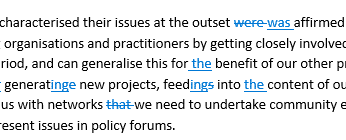By the time a document is ready to be proofread, it should have been edited already. It should already be well organised, well written, and easy to understand. Proofreading is then the final step of checking that document before it’s published. It is about finding errors that were either missed or introduced during editing.
Proofreaders ensure the document’s final draft is free of grammatical errors (e.g. subject–verb agreement problems, incorrect word choices, improper punctuation usage, and incorrect spelling) as well as formatting and typographical errors. They also make sure the document adheres to the chosen style guide.
This is different to editing, which is an earlier stage of drafting the document. It involves making suggestions to improve the overall quality of the writing and ensure it’s sharp and consistent, that it flows logically, and that it says what the author wants it to say, considering its audience. It might involve moving or rewriting or deleting whole sections of text, for example.
So editing is more like drafting, whereas proofreading is the final check to ensure no errors or typos have slipped through the cracks.


Recent Comments